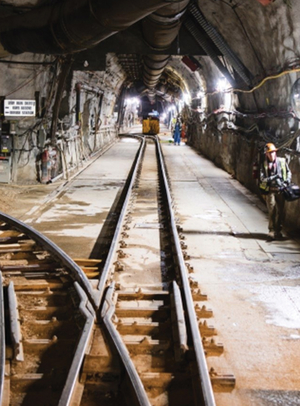Reducing the threat from terrorism and weapons of mass destruction and enhancing global strategic stability
Accelerating Drug Design with GUIDE
In response to a request from the Department of Defense’s Joint Program Executive Office for Chemical, Biological, Radiological, and Nuclear Defense, an LLNL-led, multi-institutional team is developing Generative Unconstrained Intelligence Drug Engineering (GUIDE) as a first-of-its-kind platform to accelerate medical countermeasure (MCM) development. Therapeutic antibody development to combat viruses has typically taken years. GUIDE combines data, structural biology, bioinformatic modeling, and molecular simulations, driven by machine learning and supercomputing, to rapidly design antibody candidates, potentially lower development costs and risk, and accelerate the timeline to clinical use. To date, GUIDE has demonstrated multiple cases of success in developing vaccines and therapeutic antibodies.
GUIDE researchers are currently developing large data sets to train artificial intelligence (AI) models for de novo antibody design and developability. These data sets will enable AI-based predictions of key antibody properties to facilitate unprecedented acceleration of the drug-development cycle while maintaining desired MCM critical quality attributes. GUIDE will provide a unique ability to actively respond to threats, potentially deter adversaries, and significantly advance computational biological approaches that can benefit a wide range of drug-development efforts. GUIDE is comprised of a growing coalition of interagency and public and private partners with a shared mission of transforming MCM development. When fully implemented, GUIDE will enable proactive preparedness against a broad range of known threats and reduce the development timeline from years to weeks.
Improving Capabilities to Detect Nuclear Tests
On October 18, 2023, a multilaboratory, multidisciplinary team funded by the NNSA Office of Defense Nuclear Nonproliferation R&D conducted the first Physics Experiment 1 (PE1) series explosive test, detonating 16.3 tons (TNT equivalent) of chemical explosives in Area 12’s P tunnel at the Nevada National Security Site. Shock, seismic, and acoustic signals propagated to sensors within minutes. Preliminary data reviews reported clear seismic signals to at least 250 kilometers with high data recovery rates, which will be used to improve the United States’ ability to detect low-yield nuclear explosions around the world. LLNL serves as manager of the NNSA-funded PE1 venture. Team members from LLNL, including the project engineer, deputy venture manager, chief scientist, electromagnetic instrumentation technician, seismo–acoustic instrumentation technician, meteorology instrumentation technician, and instrumentation engineer, all worked diligently in the field for months, and in some cases years, to achieve the near-flawless execution of the PE1 experiment.
Skywing
LLNL’s multidisciplinary teams of mathematicians, systems analysts, power engineers, cybersecurity experts, and computational scientists have turned to collaborative autonomy as a way to defend modern critical infrastructure and harden systems. The electrical grid that powers our homes, the pipelines that deliver water and natural gas, and our transportation networks are full of digitized components. In a power grid, distributed energy resources (DERs) such as smart meters, solar inverters, power-quality sensors, and protection devices are geographically spread out, programmable, and network connected. Collaborative autonomy is a new class of computational techniques that can be used to teach networked devices, such as DERs, how to self-organize into a collective whole. Skywing is an open-source, high-reliability, real-time platform now available to the broader research community to explore distributed decision making among infrastructure control systems for resiliency. It provides approaches and solutions for real-world applications that solve problems and lowers the barrier to entry for those who may lack fluency in collaborative-autonomy software development.
Assistance in Ukraine
After Russia’s invasion of Ukraine in 2022, multidisciplinary teams at LLNL worked at the forefront of urgent, complex operations to improve the United States’ situational awareness of a wide range of nuclear incidents in the region. Their activities informed decision-making at the highest levels of the U.S. Government and assisted with preparing for numerous contingencies with global security implications. The Ukraine Detection Assistance Team’s dedication and perseverance in assisting partners in Ukraine during this time of crisis were commended, and the team’s efforts were recognized with The Secretary of Energy Achievement Award. Along with their colleagues from the Office of Counterterrorism and Counterproliferation and the Office of Defense Nuclear Nonproliferation, these LLNL subject matter experts developed creative solutions to configure and adapt existing equipment to meet urgent needs within Ukraine and worked closely with the governments and embassies of multiple countries around the world to ensure that necessary equipment could be delivered to Ukraine within a matter of weeks. As a direct result of their efforts, the White House and other critical elements of the U.S. Government had necessary data to make sound judgments and decisions of the gravest national significance with great confidence.
Cybersecurity Training for Students
Each summer, LLNL offers advanced undergraduate and graduate students the opportunity to join the Cyber and Critical Infrastructure Summer Institute (CSI) to work as interns on cybersecurity and critical infrastructure projects. Protecting our nation’s critical infrastructure requires multidisciplinary solutions, and the CSI tests the capability of teams of interns to combine their knowledge in cybersecurity and power-systems engineering to solve unique challenges. This summer, the CSI hosted 65 interns who participated in activities including a cybersecurity capture the flag competition, tours of the National Ignition Facility and the Laboratory’s quantum computing facility, tutorials and workshops, and Q&A sessions with principal investigators. Each CSI intern was mentored by an LLNL employee working in cybersecurity and/or critical infrastructure resilience. The capstone event of this year’s CSI was a visit from U.S. Representative Eric Swalwell (D-CA14) and LLNL Director Kimberly Budil. The program is an important pipeline for developing future cybersecurity and infrastructure experts. LLNL has converted 28 interns to staff in the last five years.







